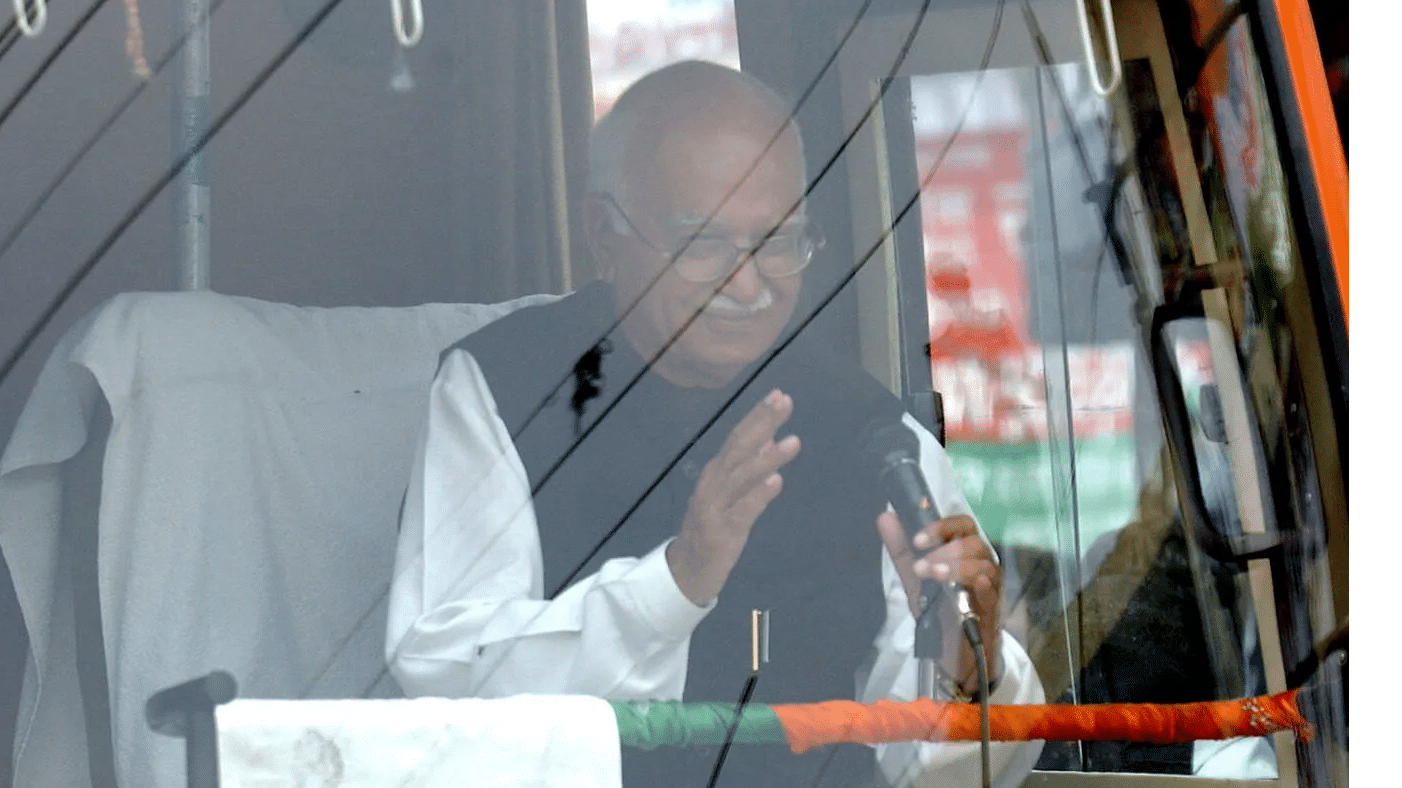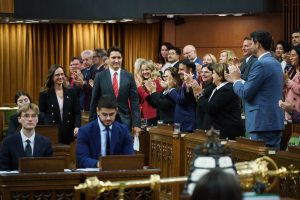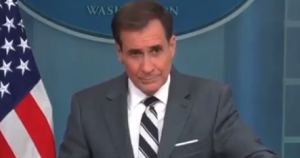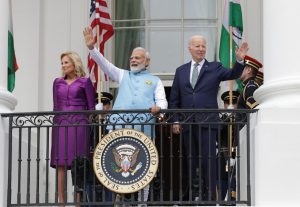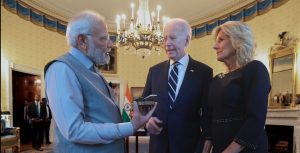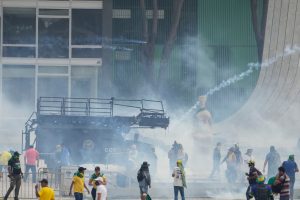In 1984, the Bharatiya Janata Party (BJP), then just a four-year-old party, decided to take up the issue of a Ram Mandir in Ayodhya in the state of Uttar Pradesh, at a place where many believe Lord Ram was born – and where the Babri Masjid had stood for over 400 years.
The party, founded by Lal Krishna Advani and Atal Bihari Vajpayee, offshooted from the Janta Party in 1980 when the alliance headed by then prime minister Morarji Desai collapsed after three years in office and the Congress led by Indira Gandhi came back to power through mid-term elections.
Karachi-born Advani, then 57 years old, took over the leadership of the Ram Janmabhoomi movement in 1984, but his pitch, unlike in 1989-90, was subtle.
Live updates: Ayodhya Ram Temple ground breaking ceremony
The BJP, till about the elections in 1984, did not gain much popularity, winning just two seats in the lower house of Parliament, the Lok Sabha. But in 1989, the BJP listed the construction of the Ram temple in Ayodhya on the disputed land in its manifesto. A legal dispute had been on over the site for decades by then.
And thereon, the party began to gain the momentum under the leadership of Advani. The BJP made a huge leap from two to 85 seats in the 1989 general elections.
On September 25, 1990, the firebrand Advani launched a rath yatra from Somnath in Gujarat to Ayodhya with the purpose of garnering support for the demand to construct a Ram temple at the spot where the Babri mosque stood then.
The saffron leader’s choice of destination was a thoughtful one.

Draped in saffron, often flashing a sword and with a tilak on his forehead, Advani began his yatra from Somnath in Gujarat. It was interestingly organised by now Prime Minister Narendra Modi, who was then an active Rashtriya Swayamsevak Sangh (RSS) worker and a protege of Advani. The plan was to halt the chariot in Ayodhya to give a symbolic message of “reclaiming” the temple in Ayodhya as was done in Somnath.
A Shiv temple in Somnath was demolished and reconstructed several times over the centuries. The last demolition came at the hands of Mughal emperor Aurangzeb in 1665. It lay in ruins until 1950 when it was again reconstructed.
Advani travelled from state to state aiming to reach Ayodhya on October 30 to participate in “kar seva”, a symbolic gesture of serving to the cause of Lord Ram. On October 23, he was arrested in Bihar’s Samastipur on the orders of then Chief Minister Lalu Yadav to prevent him from proceeding to Ayodhya in adjacent Uttar Pradesh.
In response to the arrest, the BJP withdrew support to the VP Singh government at the Centre, in which Lalu Yadav’s party RJD was also a partner. The VP Singh government fell.
In the next general election in 1991, the BJP breached the 100 mark for the first time, winning 120 seats in the 545-member Lok Sabha, riding on the Ram temple promise.
In late 1992, the BJP, led by Advani, began to mobilise kar sevaks again. On December 6, 1992, thousands of kar sevaks demolished the Babri mosque in Ayodhya. The Supreme Court had allowed the gathering only after an assurance by the Uttar Pradesh state gvernment led by the BJP’s Kalyan Singh, that no law and order problem would occur.
LK Advani along with other senior BJP leaders like Murli Manohar Joshi and Uma Bharti were witness to the mob attack on the mosque. Advani along with Joshi is still an accused in the Babri demolition case. Accused of “criminal conspiracy”, the 92-year-old denies all charges against him. Murli Manohar Joshi is now 86.
The December 6 demolition led to largescale communal rioting across the country, killing nearly 3000 people, both Hindus and Muslims.

Despite this, no settlement came for the much-awaited Ram temple, but the BJP had gained solid ground.
In the 1996 general elections, the BJP moved up its Lok Sabha tally to 161, the single largest party in the house but still way short of a majority. It could not make up the number. The government fell in 13 days, and Prime Minister Atal Bihari Vajpayee resigned after an impassioned speech in Parliament. Soon after, the United Front was created under the leadership of the Janata Dal’s HD Deve Gowda, who became the 11th prime minister of the country. But, he could not hold on to the alliance and mid-term elections were held in 1998.
Vajpayee, who had promised in his 13th-day speech to return with better numbers, did so. The BJP won 182 seats in the Lok Sabha, still 91 short of the majority mark, but formed government at the head of a 25-party alliance.
Also read: Silver brick, special soil, VIP guests for Ram Temple foundation laying ceremony in Ayodhya
From 1998-2004, the BJP-led National Democratic Alliance ruled at the Centre under the prime ministership of Atal Bihari Vajpayee, who was seen as one of few moderates in the BJP. In 2004, Atal Bihari Vajpayee called early elections banking on the NDA’s “India Shining” campaign; it was a losing move, with the BJP ceding power to the Congress-led United Progressive Alliance.
Nothing much moved on the Ram temple from 1996 to 2004, in the six-year BJP rule under the leadership of Vajpayee. Nothing much was expected to move in the Congress-led UPA rule.
In the 2009 elections, the BJP projected Advani as its PM face, but lost to the Manmohan Singh-led UPA again. With this, the golden Atal-Advani era in the party seemed to end after 29 years.
While equations were changing at the national level, another face from within the BJP was gaining popularity among the cadres.
Despite stout resistance, Advani and other senior party leaders loyal to him were forced to make way for Narendra Damodardas Modi as the BJP’s candidate for Prme Minister in the 2014 general elections. A large chunk of the party cadre rallied behind Modi, who had by then been chief minister of Gujarat for 12 successful years, a role clinched for him by his mentor LK Advani in 2001.
Narendra Modi, a new age politician with a new set of rules, changed the dynamics of electioneering, fashioning the campaign as the hope of “acchhe din” vs the rule of corruption and scams that he accused the Congress government of. The results created history, with the BJP alone winning 282 seats. It was after 30 years that a single political party got the mandate to rule on its own.
Modi’s election theme was development; the Ram temple figured, but only on page 43 of the party’s maifesto.
Till about late 2018, not much had moved on the Ram temple issue. The BJP, despite marking the issue in the manifesto, maintained that it would “go by the court judgement”.
On March 8, 2019 the Supreme Court constituted a mediation panel with FM Kalifulla as the chairman and comprising spiritual leader Sri Sri Ravi Shankar and senior advocate Sriram Panchu, to mediate in the land title dispute, but the panel failed to get a consensus. The top court, in August 2019, ordered day-to-day hearings to wrap up the issue.
It is only in November last year that a five-judge constitution bench headed by then Chief Justice Ranjan Gogoi delivered an order in the decades-old case. The court granted the entire 2.77 acres of disputed land in Ayodhya to the deity Ram Lalla and also directed the Centre and UP government to allot 5 acres of land to Muslims at a prominent place to build a mosque.
And on August 5, Narendra Modi, who once acted as a ‘saarthi’ (chariot driver) for LK Advani, finally laid the foundation stone of the temple as the ‘rathi’ (rider).

